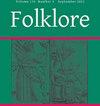The Cooked Child: Urban Legends and Ancient Myths from the Malayo-Polynesian-Speaking World
IF 0.2
4区 社会学
0 FOLKLORE
引用次数: 0
Abstract
Abstract In several publications J. H. Brunvand has discussed an ‘urban legend’ labelled ‘the baby roast’. While treating this as an American tale current in the 1970s that spread to urban locations in Europe and elsewhere, Brunvand also mentions much older Malayo-Polynesian narratives from the South Pacific exhibiting the same theme—a child-minder mistaking an infant for food and cooking it. Yet he reaches no conclusion on whether this remarkable resemblance reveals ‘cross-cultural borrowing’ or ‘independent invention’. Analysing the Pacific stories and drawing on Malayo-Polynesian narratives from Indonesia recorded by the present author, this article demonstrates that the best explanation is independent development. The article further shows how stories concerning the accidental cooking and sometimes consumption of young children reflect pan-human concerns about the possibility of cannibalism and the attribution of consuming human flesh to people implicitly regarded as inhuman or, in the Indonesian stories, to characters who subsequently transform into non-human animals.《煮熟的孩子:来自马来-波利尼西亚语世界的城市传说和古代神话》
在一些出版物中,J. H. Brunvand讨论了一个标有“婴儿烤”的“都市传说”。Brunvand认为这是20世纪70年代流行的美国故事,传播到欧洲和其他地方的城市地区,同时也提到了来自南太平洋的马来亚-波利尼西亚更古老的故事,展示了同样的主题——看护者把婴儿误认为食物并将其烹饪。然而,他没有得出结论,这种惊人的相似是“跨文化借鉴”还是“独立发明”。本文分析了太平洋地区的故事,并借鉴了作者记录的来自印度尼西亚的马来亚-波利尼西亚叙事,证明独立发展是最好的解释。这篇文章进一步展示了关于意外烹饪和有时食用幼儿的故事如何反映了全人类对同类相食的可能性的关注,以及将食用人肉归因于隐性被视为不人道的人,或者在印度尼西亚的故事中,将食用人肉归因于随后变成非人类动物的人物。
本文章由计算机程序翻译,如有差异,请以英文原文为准。
求助全文
约1分钟内获得全文
求助全文
来源期刊

FOLKLORE
FOLKLORE-
CiteScore
0.60
自引率
25.00%
发文量
0
期刊介绍:
A fully peer-reviewed international journal of folklore and folkloristics. Folklore is one of the earliest journals in the field of folkloristics, first published as The Folk-Lore Record in 1878. Folklore publishes ethnographical and analytical essays on vernacular culture worldwide, specializing in traditional narrative, language, music, song, dance, drama, foodways, medicine, arts and crafts, popular religion, and belief. It reviews current studies in a wide range of adjacent disciplines including anthropology, cultural studies, ethnology, history, literature, and religion. Folklore prides itself on its special mix of reviews, analysis, ethnography, and debate; its combination of European and North American approaches to the study of folklore; and its coverage not only of the materials and processes of folklore, but also of the history, methods, and theory of folkloristics. Folklore aims to be lively, informative and accessible, while maintaining high standards of scholarship.
 求助内容:
求助内容: 应助结果提醒方式:
应助结果提醒方式:


